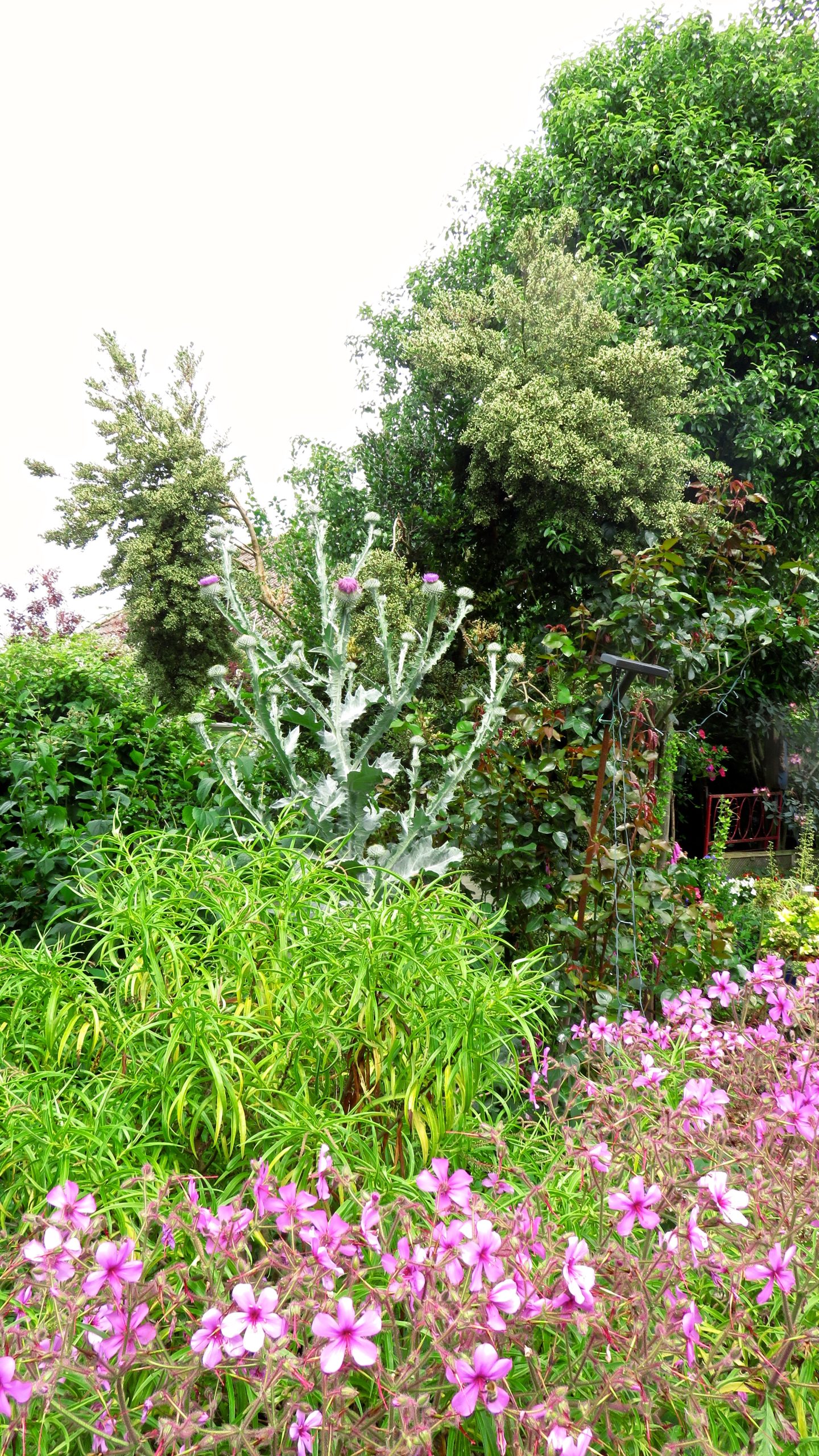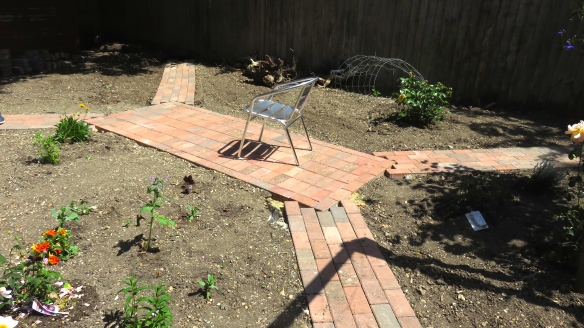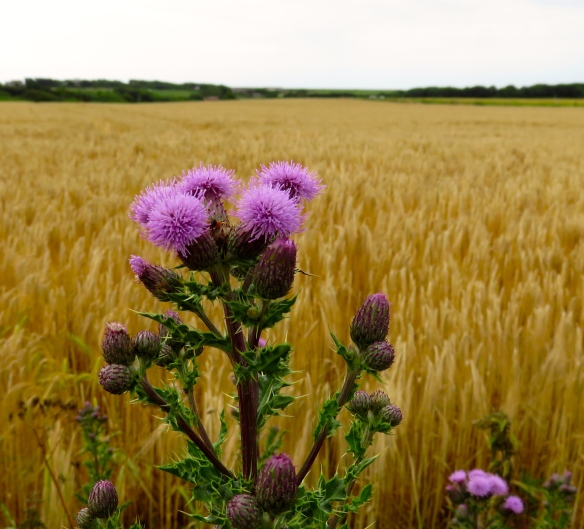After an application of Vanish, two cold washes in the machine, and a dedicated press, Jackie has achieved a renovation of the linen jacket, which was beyond the dry cleaners. And it still fits.
I began the day with a walk through Roger’s footpath, where I again met Pete, who, on this far more overcast day, I did not recognise without his sunglasses and hat.
Hoverflies and bluebottles needed their head- and tail-lights among the gloomy brambles of the hedgerows.
Can you smell the leaking slurry. I certainly could.
Encouraged by the success of the arancus, Jackie planted an astilbe in similar conditions.
While Aaron completed stage five of the rose garden paving,
Jackie and I completed the clearance of her work area in readiness for the garden shed.
The structure in the background is the central heating fuel tank, necessary because we don’t have mains gas. Until we have had a visit to the communal dump, it is probably not politic to display the various places where we have decanted the items the new structure will replace.
Common thistles grow along the footpath visited earlier,
and we now know that our giant is not a cardoon, but a cotton thistle.
This is a shame, because we had the former in Newark. Never mind, I can still talk about Yarnton’s cardoon.
Yarnton Mills was an elderly family friend of Jessica’s late parents. His wife kept sheep. She farmed her flock somewhere in Europe, where, in order to improve the quality of their milk, she fed them on cardoon. The location may have been in Spain or Portugal where ewe’s milk is used in the production of cheese. I always wondered how the animals, not being donkeys, managed to eat these thistle-like plants. I therefore amused myself with a little internet research. FIBRA explains that the crop is reduced to silage for feed. The benefits are described by Fernández-Salguero, J., Tejada, L. & Gómez, R. (2002), who tell us:  ‘The use of plant proteinases from flowers of cardoon Cynara cardunculus as milk coagulants is of particular interest because they are natural enzymes whose strong proteolytic action eventually leads to the extensive breakdown of caseins, thereby giving rise to cheeses with a soft buttery texture, a genuine aroma and a slightly piquant and creamy flavour. These cheeses are highly valued for their taste and quality and can be targeted at the lacto-vegetarian and organic markets. This type of plant coagulant can also be certified Kosher and Halal.’
‘The use of plant proteinases from flowers of cardoon Cynara cardunculus as milk coagulants is of particular interest because they are natural enzymes whose strong proteolytic action eventually leads to the extensive breakdown of caseins, thereby giving rise to cheeses with a soft buttery texture, a genuine aroma and a slightly piquant and creamy flavour. These cheeses are highly valued for their taste and quality and can be targeted at the lacto-vegetarian and organic markets. This type of plant coagulant can also be certified Kosher and Halal.’
Yarnton presented Jessica with a seed which we planted in the kitchen garden, and enjoyed for the story and for the towering plant’s sculptural qualities
This evening Jackie and I dined on gammon steaks topped with fried eggs; fresh crisp chips; and an interesting melange of recycled pasta and meatballs, green and baked beans, and the odd limp chip. Very tasty it all was, too. This was followed by mixed fruit crumble and custard. Jackie drank Hoegaarden, and I finished the bordeaux.










I have always considered stain removal a fine art. Kudos to Jackie!
‘Thank you’, she says
The Head Gardener is a woman of many talents – and you look rather pleased with her posing in that dapper white jacket! I had not heard of Cardoon before – and found all that info rather intriguing! Do I understand correctly you don’t have the plant any more? Any plans for another?
Thanks – the multi-talented lady says ‘that’s nice’. When the Newark house was sold, the cardoon stayed with it. The cotton thistle we have will probably suffice.
Kudos to Jackie for laundering the jacket. You look very spiffy in it. The dry cleaners have limits. I’ve found there are few things I really need to take to them if I’m willing to do the press work after laundering. I had never heard of cardoons until I read The Food Lover’s Garden by Angelo Pellegrini. If you want to eat them, rather than just enjoy their blossoms and seed heads, they’re a great deal of trouble. Like celery. Best to enjoy the flowers!
Thank you, Lisa. I will pass message on to Jackie. I wouldn’t fancy eating cardoon 🙂
Me either.
Interesting difference of phrasing – we would probably say ‘me neither’, or. more likely, ‘nor me’.
It’s probably a mistake. I thought about neither before hitting send. But unlikely to say ‘nor me.’ 😉
I’m sure I’ve heard it before
Kudos to vanish stain remover…. and love those flies…. amazing captures as always. .. 🙂
Thank you Chitra. Kudos appreciated
Put on that white jacket and celebrate with a visit to an Italian restaurant! (I can still remember, in Mexico, young boys in white suits jumping on the trampoline while eating taco shells filled with beetroot and tomato and runny mince. And not a drop was spilt!)
Thanks, Bruce. I wouldn’t need to be on a trampoline to mess it up again
Me neither… Nor me… me either…
🙂
Good to see the excellent result Jackie’s determination has produced. I am actually missing our Blue Bottles; can’t believe it. Must have something to do with our drought. European bees are seldom seen as well – I’m sure it is due to overuse of insecticides and herbicides. Fortunately I do have native bees visiting regularly. Sydney has enough green zones to provide habitat for them; I use my bamboo to create hotels. Another reason could be that I don’t have an ornamental garden so my flowers are more subtle and less attractive perhaps. I don’t have room for a flower garden but I enjoy other bloggers’ blooms. Thank you. 🙂
Thank you, Mary. We’ll keep the flowers coming
You are quite dapper with that jacket. Nice walk, … great pics of the flies … and cheers to your Bordeaux.
Thank you Frank
Entertaining, informative, and lovely, as always. Excellent job on the jacket, Jackie; it was well worth the effort.
Thank you, Jodie